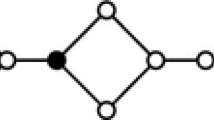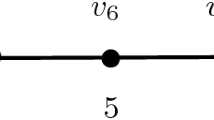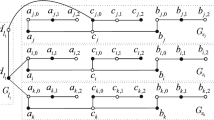Abstract
A domination coloring of a graph G is a proper vertex coloring with an additional condition that each vertex dominates a color class and each color class is dominated by a vertex. The minimum number of colors used in a domination coloring of G is denoted as \(\chi _{dd}(G)\) and it is called domination chromatic number of G. In this paper, we give a polynomial-time characterization of graphs with domination chromatic number at most 3 and consider the approximability of a node deletion problem called minimum q-domination partization. Given a graph G, in the Minimum q-Domination Partization problem (in short Min-q-Domination-Partization), the objective is to find a vertex set S of minimum size such that \(\chi _{dd}(G[V{\setminus } S]) \le q\). For \(q=2\), we prove that it is \({\mathsf {APX}}\)-complete and is best approximable within a factor of 2. For \(q=3\), it is approximable within a factor of \(O(\sqrt{\log n})\) and it is equivalent to minimum odd cycle transversal problem.






Similar content being viewed by others
References
Agarwal A, Charikar M, Makarychev K, Makarychev Y (2005) \(O(\sqrt{\log n})\) approximation algorithms for min uncut, min 2cnf deletion, and directed cut problems. In: Proceedings of the thirty-seventh annual ACM symposium on theory of computing, pp 573–581
Arumugam S, Chandrasekar KR, Misra N, Philip G, Saurabh S (2011) Algorithmic aspects of dominator colorings in graphs. In: International workshop on combinatorial algorithms. Springer, pp 19–30
Chellali M, Maffray F (2012) Dominator colorings in some classes of graphs. Graphs Comb 28(1):97–107
Chen YH (2014) The dominated coloring problem and its application. In: International conference on computational science and its applications. Springer, pp 132–145
Chlebík M, Chlebíková J (2004) On approximation hardness of the minimum 2sat-deletion problem. In: International symposium on mathematical foundations of computer science. Springer, pp 263–273
Chvatal V (1979) A greedy heuristic for the set-covering problem. Math Oper Res 4(3):233–235
Das S, Mishra S (2020) Lower bounds on approximating some variations of vertex coloring problem over restricted graph classes. Discrete Math Algorithms Appl 12(06):2050086
Dinur I, Steurer D (2014) Analytical approach to parallel repetition. In: Proceedings of the forty-sixth annual ACM symposium on theory of computing, pp 624–633
Feige U, Kogan S (2004) Hardness of approximation of the balanced complete bipartite subgraph problem. Dept. Comput. Sci. Appl. Math., Weizmann Inst. Sci., Rehovot, Israel, Tech. Rep. MCS04-04
Gera R (2007a) On dominator colorings in graphs. Graph Theory Notes N Y 52:25–30
Gera R (2007b) On the dominator colorings in bipartite graphs. In: Fourth international conference on information technology (ITNG’07). IEEE, pp 947–952
Gera R, Rasmussen CW, Horton S (2006) Dominator colorings and safe clique partitions. Congress 181:19–32
Hochbaum DS (1998) Approximating clique and biclique problems. J Algorithms 29(1):174–200
Khot S (2002) On the power of unique 2-prover 1-round games. In: Proceedings of the thiry-fourth annual ACM symposium on theory of computing, pp 767–775
Khot S, Regev O (2008) Vertex cover might be hard to approximate to within \(2-\epsilon \). J Comput Syst Sci 74(3):335–349
Krithika R, Rai A, Saurabh S, Tale P (2017) Parameterized and exact algorithms for class domination coloring. In: International conference on current trends in theory and practice of informatics. Springer, pp 336–349
Merouane HB, Haddad M, Chellali M, Kheddouci H (2015) Dominated colorings of graphs. Graphs Comb 31(3):713–727
Nemhauser GL, Trotter LE (1975) Vertex packings: structural properties and algorithms. Math Program 8(1):232–248
Papadimitriou CH, Yannakakis M (1991) Optimization, approximation, and complexity classes. J Comput Syst Sci 43(3):425–440
Shalu M, Vijayakumar S, Sandhya T (2020) On the complexity of cd-coloring of graphs. Discrete Appl Math 280:171–185
Swaminathan V, Sundareswaran R (2010) Color class domination in graphs
Zhou Y, Zhao D (2019) On domination coloring in graphs. ar**v preprintar**v:1909.03715
Zuckerman D (2006) Linear degree extractors and the inapproximability of max clique and chromatic number. In: Proceedings of the thirty-eighth annual ACM symposium on theory of computing, pp 681–690
Author information
Authors and Affiliations
Corresponding author
Additional information
Publisher's Note
Springer Nature remains neutral with regard to jurisdictional claims in published maps and institutional affiliations.
Rights and permissions
About this article
Cite this article
Das, S., Mishra, S. On the complexity of minimum q-domination partization problems. J Comb Optim 43, 363–383 (2022). https://doi.org/10.1007/s10878-021-00779-1
Accepted:
Published:
Issue Date:
DOI: https://doi.org/10.1007/s10878-021-00779-1




